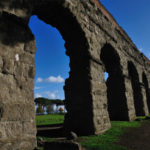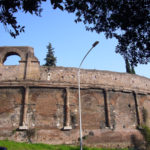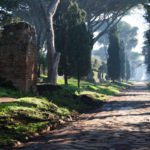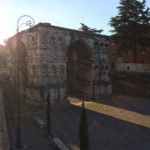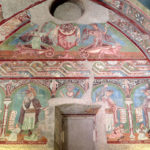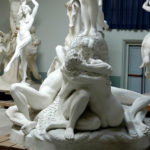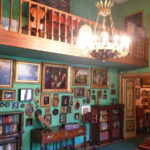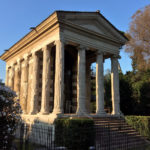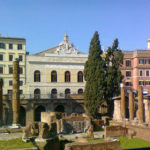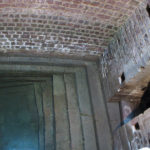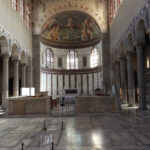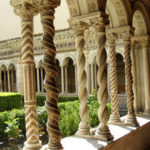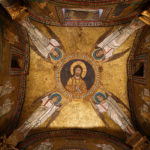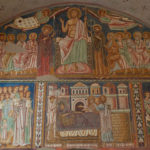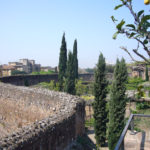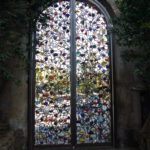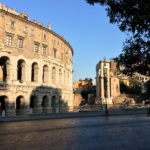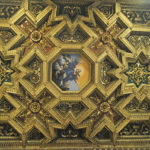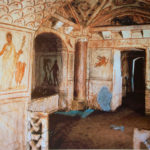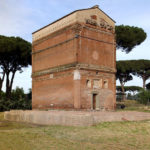Those who already know Rome, who have visited it more than once, are fascinated by things off the beaten path, but also cannot stand crowds and want to avoid them at any cost, can steer toward the never-ending alternative sites that the city offers. To visit Rome, actually, as an old saying reminds us, “one life is not enough”.

Special Tours
Runs: Daily Except Monday
Private Tours Starting Time can be taylored on clients request
AM: 9.30 Starting time available for PRIVATE and SMALL GROUP Tour
PM: 13.30 Starting time available for PRIVATE and SMALL GROUP Tour
Appia Antica
«Today I went to the ninfa Egeria, then to the Baths of Caracalla and then to the Via Appia to see the ancient tombs and the best conserved one of Cecilia Metella, which gives the concept of the stoutness of the masonry. These men worked for an eternity and calculated everything, apart from the fierce devastation of those who came after and in front of whom would have fallen». With these words the great Goethe in his “Italian Journey” recounts the walk that we propose, among nobile traces, ancient mansions, legendary towers and burial mounds. Just walking it is possible to rediscover up-close the treasures of the Via Appia Antica, guided by the romantic spirit of the “Grand Tour” and with scientific rigor that inspired the subsequent 19th Century archeological excavations.
Regina viarum, the Appia was constructed by censor Appio Claudio in 312 B.C. to connect Rome to Capua, a crossroads to the connections with the Orient, Naples and the Etruscan cities, which then became part of Magna Grecia, the better, richest and most civilized regions of the ancient world. Favored by Romans since ever (the Scipioni dynasty selected it for their family tomb) the Via Appia always evoked, during the centuries, the admiration of travelers, including the most distinguished. In the 19th century Luigi Canina organized a tour with a proper scenographic edging which brought back to life, after so many centuries, the magnificence of that «unique monument to be preserved religiously intact, for the history and legends connected to it, for its ruins and trees, for the countryside and landscape, for the solitude, the silence, its lights, the sunrises and sunsets… untouchable as the Acropolis of Athens» (Antonio Cederna).
Along the path of the Appia Antica, today, you can come across evidences and monuments that tell the history of Rome: The Gate of San Sebastian and the Aurelian Walls, the area of the Circus and of the Imperial Palace of Maxientius, the grand round mausoleum of Cecilia Metella, the Villa of Quintilli. The nearby church of San Nicola is the only example of gothic-cistercian architecture in Rome. Here in 2011 Woody Allen shot some of the scenes from his movie “To Rome with Love”.
Tombs of via Latina
The road that preceded the Via Appia in size, fame and use, preserves for over one hundred meters the original Roman pavement, with the same ancient stones on which the Roman Army walked when marching toward the Samnites. The splendid restored and visitable sepulchres are inside an enchanting archeological park which has been recently reorganized. The most notable funerary monuments are the sepulcher of the Valeri, constructed during the reign of Marcus Aurelius and that of the Pancrazi, both richly decorated with stucco and multi-colored paintings representing menhadens, satyrs, fancinful marine animals and mythological episodes. The recent organized display shows polished floor mosaics and an interesting collection of marble findings from same era.
Forum Boario and Forum Holitorum
On the banks of the Tiber river, in the mythical Velabro, strategic connecting point of the Quirinal, Campidoglio and Palatine and the obligatory route of the ancient Via Salaria, a fundamental junction for the transportation of salt and herds, Rome was born. Even before Rome, the site hosted an emporeal and commercial area where Greeks, Latins and Etruscans co-existed and shared customs and traditions. The Boario and Holitorium Forums, the ancient markets of cattle and pulses, had a decisive role in the formation of Roman civilization.
It will not be a surprise to discover that here the cult of Hercules was very popular, the mythical hero who becomes a god just by his actions, or better with his abilities, exactly as a man dedicated to commerce, in particular raising cattle: Hercules brought here the cattle of Geryon and liberated the area from the oppression of the giant Caco, terror of the local shepherds. The other deity venerated in this part of the ancient city is Venus: who better than the goddess of hospitality could meet the needs of men coming from different lands who subsisted on their own art? Known also as “fortune” or “Mater matuta” Venus is the favorite goddess of self-made men. Once again myth and history are combined and give back a unique richness of meanings to the ruins still visible today in this area: the Altar of Hercules inside the Church of S. Maria in Cosemedin, the tempietto of Hercules, the Temple of Hercules Olivario, the Temple of Portunus (goddess of hospitality), the Temple of Fortune, the Temple of Mater Matuta.
Trastevere
The most Roman neighborhood of Rome, working-class and international, movie set and favorite premises of artisans and street vendors, is named after its position on the other side of the Tiber, “trans tiberim”. A stroll through the paths and small streets of this incomparable quarter of Rome offers unsuspecting views and breathtaking sites of Tiber Island and St. Peter’s. The tour includes, in addition to the option of stopping at a gelateria on the boulevard for memorable ice cream cone, for a Roman pizza at “La Fraschetta” or for some sweets at the bakery “Innocenti”, visits to the churches of Santa Maria in Trastevere and Santa Cecilia.
Santa Maria in Trastevere is probably the first Roman church officially opened to the cult and founded by Pope Callistus in the III Century. Restored in the XII Century with the decorative marbles from the Baths of Caracalla is one of the pieces of architecture most well made of that period, with the annex from the VI and VII Centuries, as the splendid coffered wooden ceiling by Domenichino. Santa Cecilia was built on an ancient Patrician Roman mansion, the house of Valeriano, husband of Cecilia, the saint who was martyred under the Emperor Marcus Aurelius and who is today the patron of music. It is possible to visit the calidarium, the ancient part of the house where Cecilia was martyred. The church boasts unique masterpieces, including the tabernacle of Arnolfo di Cambio and the distinguished last judgment of Pietro Cavallini.
Aventino
Going away from the valley that hosted one of the most vast sporting facilities of the ancient world, the Circus Maximus, you will come upon the Aventine, the hill where Remus, brother of the founder Romulus, was buried, and which is known for the secession of the Roman Plebs. Among villas and parks, the tour includes the Basilica of Santa Sabina, best example of an early Christian basilica in Rome. The building contains the original knocker of the cyprus-wood entrance door and a splendid inscription in gold letters on an azure background. The elegant small square of the Knights of Malta at the end of Via di Santa Sabina was designed by Piranesi along with the nearby church of Saint Mary of the Priory, in a magic-like context, as all of the works of the renowned architect. The walk continues in the characteristic neighborhood of San Saba, where it is possible to admire the ruins of the Ancient Servian Walls and some Patrician domus from the III Century A.D. A short visit to the church of Saint Balbina enables the possibility to admire some masterpieces of Cosmati, the notorious Roman marble artists. The tour ends south of the Aventine where monte Testaccio emerges, a man-made hill of about 35 meters and comprised of 26 million shards of clay pots or testae in Latin. We speak mainly of amphorae used to import from the sea products of every type, from wine to oil, from honey to garum.
Sessorium
In the area of Porta Maggiore, the ancient Porta Prenestina, Settimio Severo built the imperial residence, in the area ad spem veterem, or better in the vicinity of the ancient Republican temple dedicated to the goddess Spes (Hope). The complex included, in addition to the palace, a circus and amphitheater, that the sons of the emperor, Caracalla and Elagabalo, added at a later time. A wing of the palace will be transformed into a place of worship, the Temple of Venus and Cupid, so-named because there were discovered two statues that seemed to resemble the two gods.
In the IV Century the villa was chosen by Elena, mother of the Emperor Constantine, as a private residence. Elena restored the baths and transformed a spacious basilican hall into a Christian basilica, where she kept the relics brought back from Jerusalem by herself including a piece of the cross on which Jesus Christ died. According to tradition Elena commissioned the construction of the church on the land where she had put the holy ground from mount Calvary which she herself brought to Rome together with the relics of the cross. The basilica was restored in the XVIII Century and as a result was named Santa Croce of Jerusalem, incorporating all of the buildings of the Sessorium and using columns, decorations and other fragments.
The tour includes a visit of the area, the visible remains of the Sessorium and the Basilica of Santa Croce in Jerusalem.
Saint Praxedes and Saint Pudenziana of the Esquiline
Praxedes and Pudenziana were sisters and daughters of Pudens, disciple of Paul. In the V Century, having challenged the laws of the empire by burying the martyrs, they were persecuted under Antonino Pius. The church of Saint Praxedes, with the precious chapel of Saint Zenone, commisioned by Pope Pascal I in honor of his mother Teodora, is one of the most important Byzantine monuments in Rome. A few steps from here, in Via Urbana, the ancient vicus patricius where the Roman Patrician families lived, the church of Saint Pudenziana boasts the oldest apsidal mosaic in Rome. Here, according to what it is said, Pudens was converted by the apostle Peter who lived seven years in the home of his friend.
The tour will show you a city that is capable, even in centuries of profound decadence, to produce masterpieces of art that can easily compete with the ones displayed in Constantinople and in Ravenna.
The Santi Quattro Coronati al Cielo
On the Celiolus, a secluded and silent ramification of the hills of the Celio, the Basilica dei Santi Quattro Coronati was constructed, so-called for the symbolic crown of the martyrs, the four Roman soldiers killed in 311 for having refused to participate in a pagan rite. In the quiet and intimate cloister of the monastic community that resides here, it is possible to walk in the footsteps of the history that marked the destiny of this marvelous church and is still now visible in the traces left in the later four interventions that changed its aspect, from the construction of IV Century to the restoration of the VII, IX and XXII Centuries, the last one done under Pope Pascal II.
In addition to the wooden coffered ceiling from the XVI Century, the columns of ancient granite and the ciborium of Andrea Bregno, the church boasts a wonderful medieval cloister and original frescoes from the XII Century. From the porter’s lodge of the nuns, the visitor will enter the oratory of San Silvestro, with XII Century Byzantine style frescoes, which recount the life of Constantine and represent the universally renowned donation, with which it is said that the emperor passed to the pope the temporal power of the West. The donation was fake, as was evidenced later, but it is emblematic to see the caution with which the propaganda of the church boasted it. The showpiece of the complex is the extraordinary sequence of paintings of the gothic hall, recently discovered, which rewrites the history of art of the XIII century, putting into reconsideration the supremacy of the Florence school against the Roman one. Already defined as the “Sistine Chapel of the Middle Ages”, the gothic hall represents the start of the painting tradition that will continue in Rome with Pietro Cavallini and in Florence with Giotto.
San Clemente
A few steps from the Colosseum, in Via di S. Giovanni in Laterano, the basilica of San Clemente is a site not well known enough for the treasures it has to offer. The history of the basilica can be read through the remains of the various structures that were built one over the other throughout the years, and they are still visible in the subterranean level of the church. A Patrician family built a domus on an ancient Roman structure of the I Century A.D. In an area nearby, in the following Century, the Emperor Domitian transferred the Mint from the Capitoline Hill. Later, in the same space he set up a temple for the Mythraic Rites, a very popular religion in Rome during the II Century. In the IV Century the church was constructed on the domus and the Mithraeum, which are still visible today in the excavations.
In the XII Century, devastated by the Norman invasions, Pope Clement constructed a church on top of the previous one, which today is at street level. The lower basilica maintains a sequence of XI Century frescoes, interesting not only for their rarity, but also because they enriched with a series of observations, a kind of ante litteram comic strips, which are one of the first documents in vulgar Latin. As if this were not enough, the superior Basilica displays artistic medieval treasures: in addition to the splendid works of Cosmati marble artists, of which remain the marvelous ciborium and the exceptional schola cantorum, the church still has the frescoes of Masolino of Panicale, who in this occasion perhaps worked with the great Masaccio, in the chapel of Saint Catherine.
Artists Homes & Museums
Rome caput mundi, holy city of Catholicism, cradle of western culture, since the Renaissance is the favorite destination of youths in self-growth trips and also an inescapable stop-over on the grand tour, essential for those who want to take on an important role in their time. From the Alps, the Brenner, the Po, all descend toward Rome, facing the dangers of the trip with courage and audacity. Artists, literate, philosophers and scientists all want to visit Rome, for the antiquities, the works of art, the excavations, the Roman countryside, the folklore, the intensity of the ruins, all of which reawaken the memory and the feelings of the past. Illustrious personalities decided to spend a big part of their lives in Rome, building mansions which hosted, and hosts, unique ateliers, precious libraries, exceptional furnishings, and bring back still today, in a context where the present and past merge, the memory of exemplary lives.
Museum and Home of Hendrik Andersen
The Home and Museum of Mario Praz
The home of the notable academic, sagist and literary critic, offers the visitor an all european collection: English furniture, German porcelain, French bronze, form a collection of around 1,200 pieces. The library is the jewel of the collection.
The Home and Museum of Giorgio De Chirico
Immersed in the fascinating setting of Trinita dei Monti, in Piazza di Spagna, cultural and artistic center of Rome since 1600, the home of Giorgio De Chirico offers the exclusive occasion to get up-close to the world of the artist. The original furnishings, the red damask curtains, the bronze sculptures, the studio of the painter, describe perfectly the flavor of an era.



